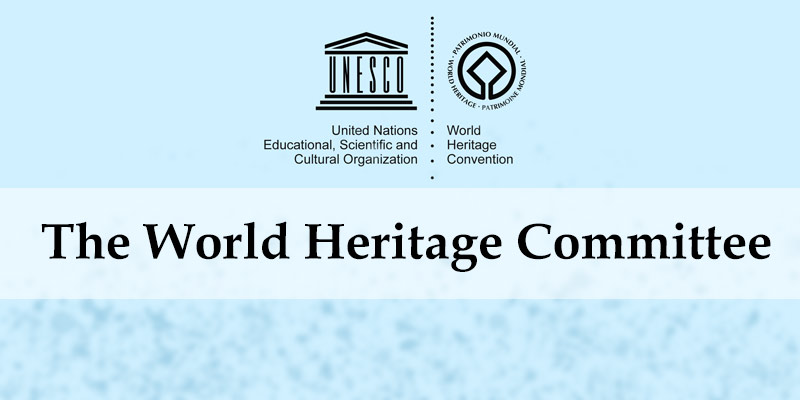- India
- Jul 13
Explainer - UNESCO World Heritage Committee
• The 46th session of the World Heritage Committee (WHC) is scheduled to be held in New Delhi, the first time in India, between July 21 and July 31.
• The session has a comprehensive agenda addressing various critical issues. Reports from the previous session and the World Heritage Centre will be reviewed. The committee will discuss the state of conservation of World Heritage properties, focusing on those inscribed on the List of World Heritage in Danger.
• According to UNESCO, there are 56 properties which the WHC has decided to include on the List of World Heritage in Danger in accordance with Article 11 (4) of the World Heritage Convention.
• Ahead of the session, the government recently launched Project PARI (Public Art of India) with works themed on India’s cultural legacy and the country's UNESCO heritage sites.
• India is now serving its fourth term as a member of the World Heritage Committee (1985-91, 2001-2007, 2011-15, and 2021-25).
World Heritage Committee
• The World Heritage Committee meets once a year, and consists of representatives from 21 of the States Parties to the Convention elected by their General Assembly.
• The Committee is responsible for the implementation of the World Heritage Convention, defines the use of the World Heritage Fund and allocates financial assistance upon requests from States parties.
• It has the final say on whether a property is inscribed on the World Heritage List.
• It examines reports on the state of conservation of inscribed properties and asks States Parties to take action when properties are not being properly managed.
• It also decides on the inscription or deletion of properties on the List of World Heritage in Danger.
What is a World Heritage Site?
• The United Nations Educational, Scientific and Cultural Organisation (UNESCO) seeks to encourage the identification, protection and preservation of cultural and natural heritage around the world considered to be of outstanding value to humanity.
• This is embodied in an international treaty called the ‘Convention Concerning the Protection of the World Cultural and Natural Heritage’, adopted by UNESCO in 1972.
• A World Heritage Site is a place having a special cultural or physical significance and outstanding universal value to humanity. It may be a building, a city, a complex, a desert, a forest, an island, a lake, a monument or a mountain.
• Sites recognised as being of Outstanding Universal Value are inscribed each year on the World Heritage List.
World Heritage Sites in India
• The number of UNESCO World Heritage Sites in India grew to 42 with the ‘Sacred Ensembles of the Hoysala’ finding a place in the coveted list in September 2023.
• These sites include 34 in the cultural category, seven in the natural category and one mixed property.
• They include Red Fort, Humayun Tomb and Qutub Minar in Delhi; Taj Mahal in Agra; ancient Nalanda university ruins and the Mahabodhi Temple in Bihar; and Santiniketan in West Bengal.
• Currently, India has the sixth largest number of (UNESCO) sites in the world. The countries that have 42 or more world heritage sites are Italy, Spain, Germany, China and France.
World Heritage Convention
• The idea of creating an international movement for protecting heritage emerged after World War I.
• The General Conference of UNESCO adopted the Recommendation concerning the Protection at National Level of the Cultural and Natural Heritage on November 16, 1972.
• The 1972 Convention concerning the Protection of the World Cultural and Natural Heritage developed from the merging of two separate movements: the first focusing on the preservation of cultural sites, and the other dealing with the conservation of nature.
• The Convention entered into force on December 17, 1975, three months after the date of the deposit of the twentieth instrument of ratification, acceptance or accession.
• India ratified the World Heritage Convention in November 1977.
• Since 1977, the World Heritage Committee has diligently convened annual ordinary sessions to address critical issues pertaining to the conservation and management of globally significant cultural and natural sites.
• By signing the Convention, each country pledges to conserve not only the World Heritage sites situated on its territory but also to protect its national heritage.
• The States Parties are encouraged to integrate the protection of the cultural and natural heritage into regional planning programmes, set up staff and services at their sites, undertake scientific and technical conservation research and adopt measures which give this heritage a function in the day-to-day life of the community.
• The Convention, further, stipulates the obligation of States Parties to report regularly to the World Heritage Committee on the state of conservation of their World Heritage properties.
• These reports are crucial to the work of the Committee as they enable it to assess the conditions of the sites, decide on specific programme needs and resolve recurrent problems.
• It also encourages States Parties to strengthen the appreciation of the public for World Heritage properties and to enhance their protection through educational and information programmes.
Manorama Yearbook app is now available on Google Play Store and iOS App Store


